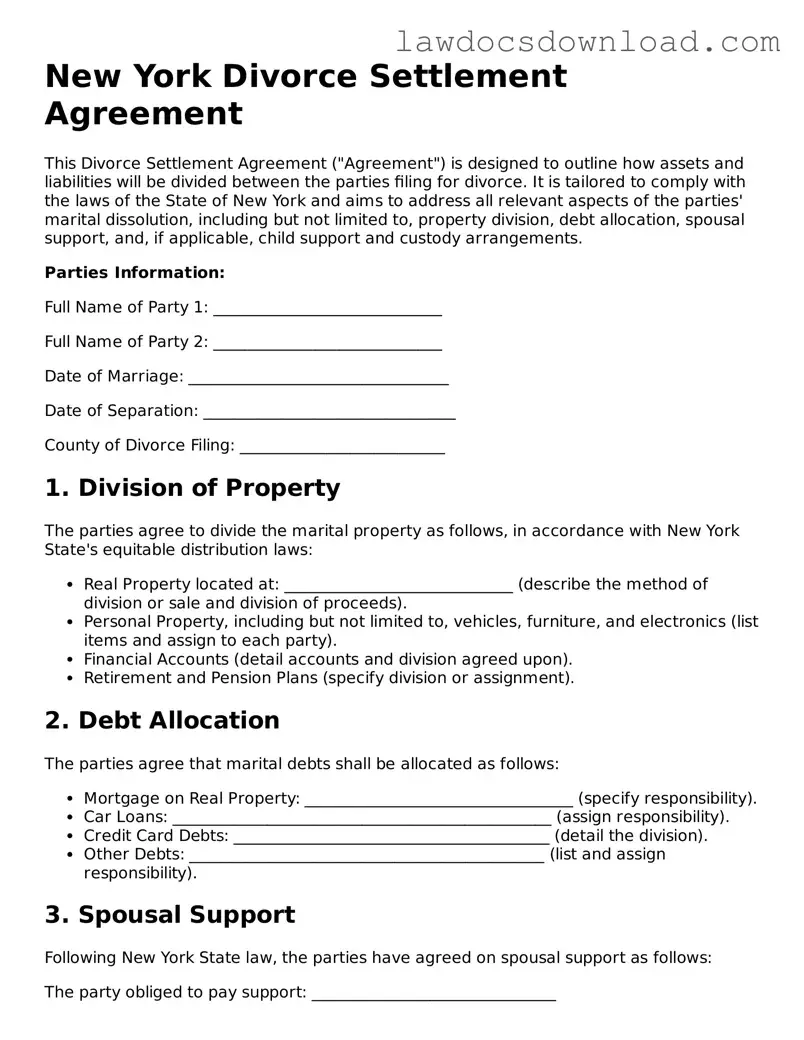New York Divorce Settlement Agreement
This Divorce Settlement Agreement ("Agreement") is designed to outline how assets and liabilities will be divided between the parties filing for divorce. It is tailored to comply with the laws of the State of New York and aims to address all relevant aspects of the parties' marital dissolution, including but not limited to, property division, debt allocation, spousal support, and, if applicable, child support and custody arrangements.
Parties Information:
Full Name of Party 1: _____________________________
Full Name of Party 2: _____________________________
Date of Marriage: _________________________________
Date of Separation: ________________________________
County of Divorce Filing: __________________________
1. Division of Property
The parties agree to divide the marital property as follows, in accordance with New York State's equitable distribution laws:
- Real Property located at: _____________________________ (describe the method of division or sale and division of proceeds).
- Personal Property, including but not limited to, vehicles, furniture, and electronics (list items and assign to each party).
- Financial Accounts (detail accounts and division agreed upon).
- Retirement and Pension Plans (specify division or assignment).
2. Debt Allocation
The parties agree that marital debts shall be allocated as follows:
- Mortgage on Real Property: __________________________________ (specify responsibility).
- Car Loans: ________________________________________________ (assign responsibility).
- Credit Card Debts: ________________________________________ (detail the division).
- Other Debts: _____________________________________________ (list and assign responsibility).
3. Spousal Support
Following New York State law, the parties have agreed on spousal support as follows:
The party obliged to pay support: _______________________________
The amount of support: ________________________________________
The duration of payments: _____________________________________
4. Child Support and Custody (if applicable)
If the parties share minor children, they have agreed to the following terms concerning child support and custody:
- Custody Arrangement: ________________________________________ (detail physical and legal custody).
- Child Support: _____________________________________________ (outline amount, schedule, and duration).
- Healthcare and Insurance: ___________________________________ (specify how costs will be covered).
- Education Expenses: ________________________________________ (detail responsibility for payment).
- Other: __________________________________________________ (address any additional agreements).
5. Other Provisions
Any other agreed-upon terms between the parties (such as tax filing status, life insurance policies, etc.) are as follows:
_________________________________________________________________________
_________________________________________________________________________
This Agreement is intended to be a final disposition of the matters addressed herein and may be used as evidence and incorporated into a final judgment of divorce or dissolution.
Party 1 Signature: _____________________________ Date: ____________
Party 2 Signature: _____________________________ Date: ____________
Notary Public: __________________________________ Date: ____________
